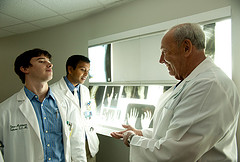Welcome to the future fellow blog readers! If you are an aspiring medical doctor, listen up. If you go to the New York University School of Medicine, you may be asked to examine a virtual cadaver.
An article explains why students were asked to dissect a virtual cadaver, instead of an actual dead body. Actual cadaver’s, although they have been used for centuries to help teach aspiring doctors, are imperfect because of death and other factors. A cadaver must meet many qualifications to be used for research and teaching. The entire medical history must be known, and all vital organs and veins must be present for teaching purposes. But now, with this new technology from Nvidia, medical students can examine a virtual cadaver that is projected on to a screen.
With this new technology, the body can be dissected just as a real cadaver might, but with certain added bonuses. One student, Chana Rich, says that the new technology is particularly useful because she can continually replace organs and veins and it looks as though they had never been removed. Also, the interactive screen allows more students to examine the body and more easily. However, some people disagree. The general consensus among students and professors alike mirror that of a first year medical student Susanna Jeurling. “I don’t think this will ever replace cadavers. There’s something about being able to hold it and turn it in your hand.”
Despite the possible disadvantages, virtual cadavers are a valuable resource to be used in addition to the examination of actual cadavers. Professors at the NYU Medical School, and developers of the virtual body technology have great dreams for their invention. Expansion of the technology into everyday lives is in the plan for the new program, to be used as a useful tool for students in all types of education.
Do you feel that a virtual body can replace an actual cadaver? What are other possible advantages or disadvantages that you have thought of that aren’t outlined in this post?



sar418
Wow, it’s amazing how much we are advancing with technology. At Hofstra Medical School, their whole learning progress is down virtually. You even get to practice surgeries without actually touching a body, it’s like it’s a video game. My dad has told my siblings and I that technology is going to take over the medical field, that doctors won’t be needed in such an abundance in the future, as they are now. I think it’s great that virtual cadavers exist and can be used for practice, but I don’t think they can ever replace an actual human body. Factors include smell and emotion. Dead anything smells bad, I promise. You have to also emotionally understand that you are working on a human being, not a machine. Look at laparoscopic surgery; you no longer even open a person up completely. This is the type of surgery I had done to remove my appendix, the whole thing was viewed from a screen, not looking at the organs first hand! http://emedicine.medscape.com/article/1582228-overview#a15